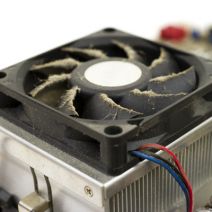 Computer components generate a large amount of heat. When your equipment overheats it can increase the chance of a crash or other issues. Long term heat issues can even cause damage to your hardware. Here are some best practices for keeping your expensive technology cool.
Computer components generate a large amount of heat. When your equipment overheats it can increase the chance of a crash or other issues. Long term heat issues can even cause damage to your hardware. Here are some best practices for keeping your expensive technology cool.
Room to Breathe
Keeping room for air flow around desktops and servers is important. You will want to give your hardware several inches of space around the air vents on the sides, front, and back. Keeping vents clear is crucial when it comes to the stability and longevity of a server or desktop. Air typically gets sucked in through the front and expelled out the back in order to cool the extremely hot components inside; when positioning several machines in a small area you will want to make sure they are facing the same way for the best airflow.
Utilize a Server Rack
Server racks let you mount your servers vertically, saving space and promoting good airflow. Some racks even have built-in cooling systems. One important piece of advice for server racks: if there are empty areas on the rack (where additional servers would go) cover them up with blanking panels. This will make airflow more efficient.
Keep Dust at a Minimum
Dust, hair, carpet fibers, and other gunk can clog up fans, insulate electronics, and cause all sorts of issue for your hardware. Keeping the area around your mission-critical equipment is very important, and having a technician dust out servers every few months will improve the lifespan of your hardware.
Cable Management
Keeping the plethora of wires and cables behind your servers organized is a pretty big task, but it will help keep things clean and improve airflow. This clears up a major eyesore as well, and can also generally shorten any physical maintenance that needs to be done because everything is neat and tidy.
Air Conditioning
You may notice your server room (or closet) is pretty stuffy. If so, you may want to ensure that the room itself has proper airflow and if your building uses air conditioning, the cool air vents into your server room. For larger operations with multiple servers, you may want to consider specialized A/C units designed for server rooms. While this is no small investment, neither was the technology you are trying to take care of.
Virtualization
If you don’t have a lot of space but need to expand your IT infrastructure and get more servers, consider virtualization. Virtualization allows you to run multiple server environments on a single machine, saving resources, electricity, and generating less heat.
Does your server room feel hot and stuffy? It’s time to clean up and future-proof your IT infrastructure. Contact Vantage Point at 225.242.9309 to talk about ways to improve the longevity and stability of your existing IT!
Source: vp 500

